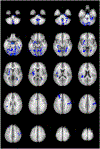Relationship between fMRI response during a nonverbal memory task and marijuana use in college students
- PMID: 29754029
- PMCID: PMC6756147
- DOI: 10.1016/j.drugalcdep.2018.03.025
Relationship between fMRI response during a nonverbal memory task and marijuana use in college students
Abstract
Marijuana (MJ) is widely used among college students, with peak use between ages 18-22. Research suggests memory dysfunction in adolescent and young adult MJ users, but the neural correlates are unclear. We examined functional magnetic resonance imaging (fMRI) response during a memory task among college students with varying degrees of MJ involvement. Participants were 64 college students, ages 18-20, who performed a visual encoding and recognition task during fMRI. MJ use was ascertained for 3 months prior to scanning; 27 individuals reported past 3-month MJ use, and 33 individuals did not. fMRI response was modeled during encoding based on whether targets were subsequently recognized (correct encoding), and during recognition based on target identification (hits). fMRI response in left and right inferior frontal gyrus (IFG) and hippocampal regions of interest was examined between MJ users and controls. There were no group differences between MJ users and controls on fMRI response during encoding, although single sample t-tests revealed that MJ users failed to activate the hippocampus. During recognition, MJ users showed less fMRI response than controls in right hippocampus (Cohen's d = 0.55), left hippocampus (Cohen's d = 0.67) and left IFG (Cohen's d = 0.61). Heavier MJ involvement was associated with lower fMRI response in left hippocampus and left IFG. This study provides evidence of MJ-related prefrontal and hippocampal dysfunction during recognition memory in college students. These findings may contribute to our previously identified decrements in academic performance in college MJ users and could have substantial implications for academic and occupational functioning.
Keywords: Adolescence; Marijuana; Memory; fMRI.
Copyright © 2018 Elsevier B.V. All rights reserved.
Figures




References
-
- Abboussi O, Tazi A, Paizanis E, El Ganouni S, 2014. Chronic exposure to WIN55,212–2 affects more potently spatial learning and memory in adolescents than in adult rats via a negative action on dorsal hippocampal neurogenesis. Pharmacol Biochem Behav 120, 95–102. - PubMed
-
- Agosti V, Nunes E, Levin F, 2002. Rates of psychiatric comorbidity among U.S. residents with lifetime cannabis dependence. Am J Drug Alcohol Abuse 28(4), 643–652. - PubMed
-
- Beason-Held LL, Golski S, Kraut MA, Esposito G, Resnick SM, 2005. Brain activation during encoding and recognition of verbal and figural information in older adults. Neurobiol Aging 26(2), 237–250. - PubMed
-
- Becker B, Wagner D, Gouzoulis-Mayfrank E, Spuentrup E, Daumann J, 2010. Altered parahippocampal functioning in cannabis users is related to the frequency of use. Psychopharmacology (Berl) 209(4), 361–374. - PubMed
-
- Blumenfeld RS, Ranganath C, 2007. Prefrontal cortex and long-term memory encoding: an integrative review of findings from neuropsychology and neuroimaging. Neuroscientist 13(3), 280–291. - PubMed
Publication types
MeSH terms
Grants and funding
LinkOut - more resources
Full Text Sources
Other Literature Sources
Medical
Miscellaneous

